
Ship's Surgeons as Barbers Page Menu: 1 2 3 4 5 6 7 Next>>
The Ship's Surgeon as BARBER-Surgeon, Page 3
Would Men Usually Be Shaved By Barbers?
In today's world, it would seem extraordinary to most men to be shaved by someone else. This is not to say that they wouldn't like to have a barber shave them, it's just that this would be inconvenient, time-consuming and expensive. The world was a different place during the golden age of piracy however.
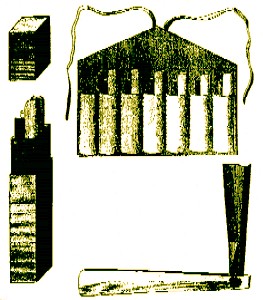
Mid 18th Century Razors from Encyclopedie des
Sciences et Metiers
Vol. 7, p. 116,
by Denis Diderot (1769)
Rory McCredie explains that barbers were used more often in the past than they are today because razors were very expensive.1 During his apprenticeship, German barber-surgeon Johann Dietz fell into the River Spree while going to shave a customer at his house. Dietz explained that "the worst was this: the silver bowl and the silver flask, together with the wallet of razors and silver-mounted knives, was lost; over a hundred thalers in value."2 By way of comparison, Dietz bought a medicine chest for when he was hired as a sea-surgeon for a whaling vessel several years later for 12 thalers.
In addition to the tools being expensive, "most men did not have the time, money, skill or courage to [shave] themselves."3 McCredie suggests that most men went to the barber for a shave once or twice a week. In his diary, Samuel Pepys reveals that he often had a barber come to his house

Artist: Michel Ange Houasse via WikiGallery
The Barber Shop (1719)
on Sundays in the early 1660s to shave him before church.4
When the barber didn't shave him, Pepys used a pumice (lava-based) stone. As he explains, Pepys shaved himself, "which I have this week done every morning, with a pumice stone, which I learnt of Mr. Marsh, when I was last at Portsmouth; and I find it very easy, speedy, and cleanly, and shall continue the practice of it."5
While Pepys doesn't specifically state why he used pumice, it might have been for several different reasons - he was afraid to use a razor, he wanted to save money on barbering or it was just more convenient as he hints in his diary.
Six days later, "in a suddaine fit cut off all my beard, which I had been a great while bringing up, only that I may with my pumice-stone do my whole face, as I now do my chin, and to save time,
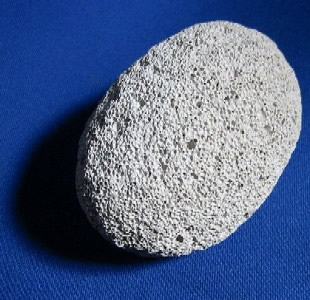
Pumice Stone
which I find a very easy way and gentile."6
Pumice stone is still used today for shaving. Kenneth Coppens explains in an article on ehow.com that it "works by rubbing a porous material, such as a pumice stone, against the skin, which eventually pulls the hair away."7 Coppens goes on to assure readers that when it is "done correctly, this technique is pain-free and the results can last longer than shaving."8
Another website gives a slightly different account, cheerfully advising that the skin in the area regularly shaved with pumice "often toughens up over time, meaning the first few pumice treatments may cause very minor irritation, but this is normal."9
Pepys eventually bought himself a straight razor, which he used to shave with every day.10 He explains in one diary entry that he was "shaving myself (wherein twice now, one after another, I have cut myself much, but I think it is from the bluntness of the razor)"11. He makes an interesting comment about the necessity of shaving, explaining "I find that without being shaved I am not fully awake, nor ready to settle to business"12.
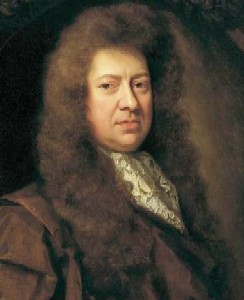
Artist: Sir Godfrey Kneller
Samuel Pepys (1689)
It may sound curious that men would be afraid to use a straight razor. However, as we shall see, straight razors at this time were not nearly as well developed as the type with which we are familiar. The razor in use during the golden age of the pirates was sharpened the full length of the blade up to the handle, unlike the modern blade which is only partially sharpened. In addition, the blade was not scalloped like blades are today. [See the images below right.]
It can be readily imagined how slippery the straight angled side of an 18th century blade would become when covered with soap. This could result in the razor slipping, leading to nicks and cuts - not only on your face, but on your fingertips as well.
The concern men had about shaving themselves is further highlighted in a French book published 45 years after the end of the golden age. Much of the introduction of this book is spent exhorting men to shave themselves. The author even resorts warning readers that "many barbers use razors & soaps that were used to shave unhealthy people with sores, pimples, and sometimes fatal diseases, which can pass into the mass of blood and produce a cruel toll"13. He further suggests that the towel used by the barber will "communicate any [virus wiped from another customer] to those who have a shave that day."14 Such a sales pitch for saving all that time, money and trouble hints at how challenging it was to get men to use razors at this time.
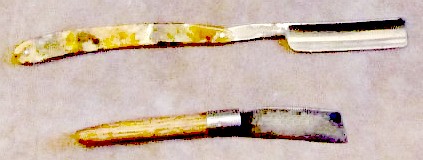 Photo: Mission The Author's Modern Straight Razor (Top) and Reproduction 18th c. Straight Razor (bottom). Note the difference in the way the blade is sharpened - the Modern Blade is Only Partially Sharpened While the 18 century Razor is fully sharpened . |
 Photo: Mission The End of the Modern Straight Razor. Note the Scalloping in the Blade for Fingers. |
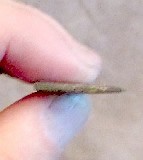 Photo: Mission The End of the 18th. c. Straight Razor. Note the Lack of Scalloping on the Blade. |
1 Rory W. McCreadie, The Barber Surgeon's Mate of the 16th and 17th Century, p. 30; 2 Johann Dietz, Master Johann Dietz, Surgeon in the Army of the Great Elector and Barber to the Royal Court, Translated by Bernard Miall, p. 40; 3 McCreadie, ibid.; 4 Robert Latham and William Matthews, The Diary of Samuel Pepys Vol. 10 Companion, p. 101; 5 Samuel Pepys, The Diary of Samuel Pepys, May 25th, 1662 entry; 6 Pepys, May 31st, 1662 entry; 7,8 Kenneth Coppens, "Removing Stomach Hair With Pumice Stone", ehow.com, gathered 11/6/13; 9 What Are the Best Tips for Pumice Hair Removal?, www.wisegeek.com, gathered 11/6/13; 10 McCreadie, ibid.; 11 Pepys, January 29th, 1664 entry; 12 Pepys, June 2nd, 1667 entry; 13 Jean-Jacques Perret, La Pogonotomie, interpreted by Mark Kehoe, p. iv; 14 Perret, p. v
Would Sailors and Pirates Be Clean-Shaven?
"Up betimes, and shaved myself after a week's growth, but, Lord! how ugly I was yesterday and how fine to-day!" (Samuel Pepys, The Diary of Samuel Pepys, September 17, 1666)
One 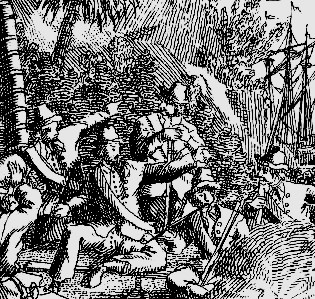
Artist: Benjamin Cole
Edward Lowe's Men Drinking, from Histoire der
Engelsche zee-roovers (1725) of the modern beliefs about sailors and pirates is that they would be dirty and unshaven, something which is often affirmed in the popular media. Part of this may have grown out of the myth the surrounds Blackbeard, as was mentioned on the first page. Part of it probably comes from the notion that when men are cooped up together for months in a closed environment they would abandon some of the societal niceties. (This would seem to be doubly true in when the subjects were a group of criminals .)
However, facial hair was out of fashion in the late 17th and early 18th centuries in Western Europe and being clean-shaven had become common.1 While visiting Surat, sailor Bruce Ingram stopped to be shaved, reporting in 1702 that the Gentoos [Hindus] "shave without soap very fine and easie, pare the nails very swiftly with a small iron like a chisel for that purpose, and will cramp you likewise, which is pulling or twisting the joints of the fingers, arms, shoulders, neck, legs, etc. till they crack, at which they are nice."2 (Cracking joints! Yet another fascinating service offered by barbers.)
In May of 1721, George Shelvocke's privateers were somewhere near Coiba Island, Panama where they took a Spanish vessel, the de Conception de Recova. As Shelvock explains in his account:
I must here observe, that upon their [the Spaniards] being first sent on board of us, they were astonish'd to see my people so thin sown, our scanty number not making any manner of show in so large a ship as ours, and those that remain'd of us being clean shav'd, they pronounced my people to be lads, from the artificial smoothness of their faces, and regretted their hard fate in being taken by such an inconsiderable company of boys, as they termed them.4
Shelvocke's voyage had begun in 1719 in the ship Speedwell. In May of 1720, the Speedwell wrecked on Juan Fernandez Island (off the coast of Chili) while gathering water and many of the ship's supplies were lost.Whether the surgeon preserved the razors is not stated. However, they remained on this island until October of the same year, escaping by constructing a boat and making their way back to the Chilean coast. All this suggests that the Englishmen had gone to some effort to still be clean-shaven a year later.
In support of the notion that sailors would be clean-shaven, much of the artwork depicting them from around this period shows them in this state. One must always be cautious of relying on artwork to accurately represent such things from period; paintings were often done to represent an ideal rather than reality. Still, few of the images of sailors from around this time show them being bearded, let alone unshorn.4
There is one example of an 'English Admiral' who appears to have a few days growth on his face in the last image. This is from a series of engravings by German artist Christoph Weigel which show fashions of various nations in 1703. This may suggest that sailors may have gone unshaven at sea, but in a discussion with Chris Thomas on the Authentic Pirate Living History Facebook group, he pointed out that the contemporary idea of clean-shaven likely meant the men were shaved every three to four days at best.5 It would be highly unlikely that the surgeon or his mates would shave the men more often that that, which nice explains the facial hair seen in that image.
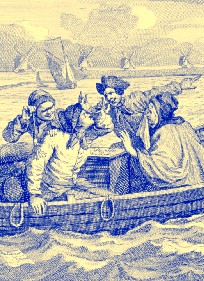 Artist: William Hogarth The Idle 'Prentice Turned Away and Sent to Sea (1747) |
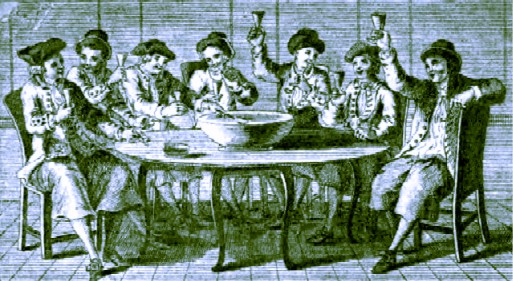 Artist: Unknown A Group of Sailors Drinking and Toasting - From The British Sailors Loyal Toast, Taken from The British Tar in Fact and Fiction, p.136 (1738) |
 Artist: John Simon The Sailor's Happy Return, from The British Tar in Fact and Fiction, p. 384 (1737) |
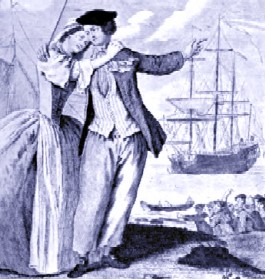 Artist: L.P. Boitard The British Sailor's Farewell, from The British Tar in Fact and Fiction p. 42 (1744) |
 Artist: Christoph Weigel Englischer Admiral zur See, from Herzog August Bibliothek Wolfenbuttel, p. 97 (1703) |
Late 17th century artist Abraham Storck and early 18th century English artist Peter Monomy also showed a variety of port scenes with sailors on their ships, most apparently beardless. (It is hard to be certain of the facial in all the images due to the lack of detail, although none clearly show beards.)
 Artist: Abraham Storck Shipping off Amsterdam Detail 1 (Late 17th c.) |
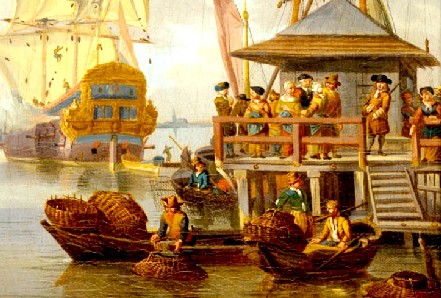 Artist: Abraham Storck Shipping off Amsterdam Detail 2 (Late 17th c.) |
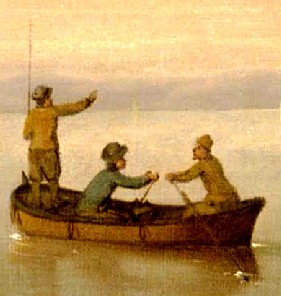 Artist: Peter Monamy Royal Yacht Becalmed at Harbor (1710-1730) |
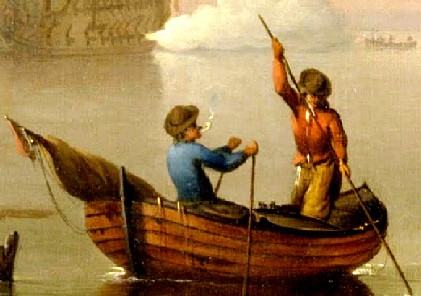 Artist: Peter Monamy Detail 2 from Royal Yacht Becalmed at Harbor (1710-1730) |
Lest you think it must surely have been different amongst the pirates, much of the period and near-period artwork depicting them shows them having no facial hair either. In all fairness, the artist who depicted them probably never laid eyes on any of them, but it is still notable that of the wide variety of pirates who appear in these engravings none of them are shown with facial hair. (Note that all this images with the exception of Henry Every - which is from an engraving - come from various editions of The General History of the Pyrates. The 1725 images are from a Dutch edition, Histoire der Engelsche zee-roovers.)
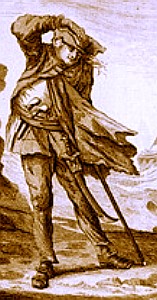 Artist: Joseph NIcholls Edward Low (1736) |
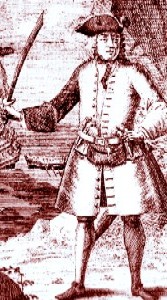 Artist: Unknown Henry Every (1734) |
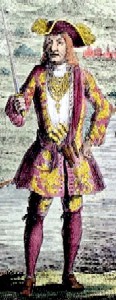 Artist: Benjamin Cole Bart. Roberts (1724) |
 Artist: Benjamin Cole Jack Rackham (1725) |
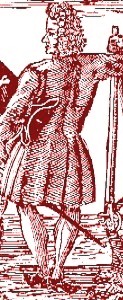 Artist: Benjamin Cole Stede Bonnet (1725) |
The idea that many pirates would have had facial hair seems to have come about with the resurgence of interest in pirates in the late 19th and early 20th century, possibly as a way to emphasize their anti-social nature.
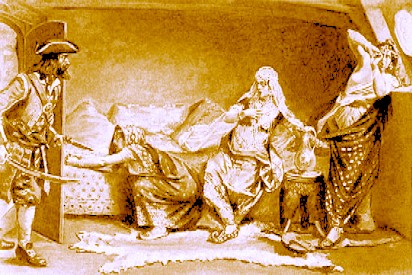 A Now Very Bearded Henry Every Discovers the Mogul's Granddaughter, from The Works of Daniel Defoe, Volume 12, Frontispiece, 1905 |
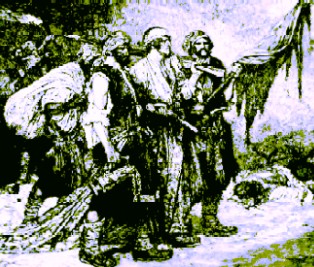 Artist: Howard Pyle The Sacking of Panama (1887) |
1 Beard, wikipedia.com, gathered 11/9/13; 2 Francis Rogers. from Bruce S. Ingram's book Three Sea Journals of stuart times, 1936, p. 184-5; 4 George Shelvocke, A Voyage Round the World by Way of the Great South Sea, 1726, p. 373; 4 Thanks to Chris Boyce for pointing this out in a discussion on beards and shaving on the Authentic Pirate Living History on July 18, 2013; 4 Chris Thomas, Authentic Pirate Living History Facebook Group Discussion, gathered 8/20/19. Chris's comment: "...we should consider what clean shaven meant in period. During the c18th the British Army was basically clean shaven in contemporary terms, but this seems to have meant shaving most but not every day for officers, and mostly twice a week for the men: so hardly the baby smooth look we associate with the term today."
The Sea-Surgeon as Barber, Part 1
Barbering would be looked at as being an inferior job by many land-based surgeons, but it had to be performed shipboard
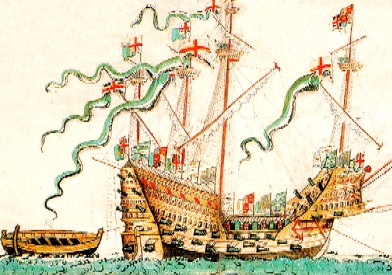
The Mary Rose from Anthony's Roll (1546)
by someone who could handle the sharp, slippery blades. The ship's surgeon was the most likely candidate.
Upon recovering Henry VIII's sunken warship, the Mary Rose, the archeologists found the remains of a surgical chest which included razors and a brass shaving bowl. Author Kevin Brown notes that these tools "show the dual role of surgeon as doctor and barber, although haircutting, trimming of beards and shaving were most probably tasks relegated to the assistant surgeon."1
Like Brown, period books suggest that shaving the men would be relagated to the surgeon's assistants or surgeon's mates rather than performed by the surgeon himself. While visiting a West-Indian shallop, naval physician Thomas Aubrey frames the attitude towards barbering when he sniffs, "They had a kind of a Barber-Surgeon on Board, which they might have as well been without, only that he served well enough to shave and bleed."2

Artist: Abraham Bosse -
Le Barbier (1630s)
The surgeon would still be trained in how to shave from his apprenticeship. In his instructions to a surgeon's mate, sea-surgeon John Woodall advised them, "But let mee frien[d]ly tell the Surgions Mate, it is the credit of a young Artist to take the vaine [bleed a patient] smoothly and neate, as also to shave well is praise worthy, wherfore I wish him to practice to doe it, and to be ever learning, for I assure him he shall never know halfe hee ought to know though he doe his best."3
Thus it is pretty clear that shaving was among the surgeon's duties, whomever he had doing the actual work. When talking about the money a naval ship's surgeon received John Atkins specifically linked shaving to the 'Two-Pences' which were paid monthly to the surgeon from each sailor's salary. He speculated, "this might have originally been the Gratuity for shaving, or taking Care the Crews were shaved"4.
1 Kevin Brown, Poxed and Scurvied: The Story of Sickness and Health at Sea, p. 23; 2 Thomas Aubrey, The Sea-Surgeon or the Guinea Man’s Vadé Mecum., p. 80; 3 John Woodall, the surgions mate, from the section "The Office and dutie of the Surgions Mate", p. 2-3;4 John Atkins, The Navy Surgeon, Introduction, (p. 19)
The Sea-Surgeon as Barber, Part 2
Of course, not all shaving involved the daily scraping of a man's face. During various surgeries, the surgeon would need to shave a body part before proceeding with the cure. A surgeon (or at least his assistants or mates) had to be deft enough with a period straight razor to accomplish the task. Let's look at a few period examples of this.
Most of the surgical examples that specifically mention shaving involve removing the hair on the head. This usually occurred when someone hit or was struck in the head and the surgeon needed to check to see if the skull was fractured.
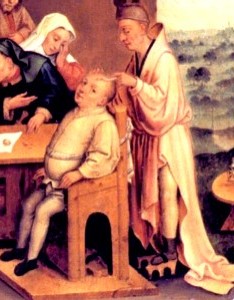
Cutting the Stone, After Hieronymus Bosch
Military surgeon William Clowes explained in the late 16th century that "all such great wounds in the head, with fracture of the skull, are holden of the best writers and practisers to be most perilous and dangerous; the bone being compressed on Dura mater (the outermost layer of menenges that surrounds the brain - dura mater is literally Latin for 'tough mother'). For the which cause, at the very beginning of this cure, I did cut and shave away the hair round about the wound. Then with my fingers I did manifestly feel a notable fracture or break in the skull on the left side of the head…the fracture of the skull was greater in length than the wound in the flesh, for that cause without detracting of time I made incision, and so followed the fracture until all the rift or cracked bone was wholly discovered."1
Fellow military surgeon Richard Wiseman was a fan of shaving the head when a scalp wound was suspected, although he does not seem to have done the work himself. He typically explains in his manuscript that he 'caused the hair to be shaved off', presumably by an assistant, so that he could better examine wounds on the skull.2 Sea surgeon John Woodall delegates this task to the surgeon's mate, advising him in treating wounds of the head to "First let the haire be shaven away"3. After examining a 'young Lad' who had been hit in the head with a 'dog' (hook for moving heavy objects), fellow sea surgeon John Atkins likewise "had the Head shaved"4, probably by an assistant or mate.
In his seminal work, sea surgeon John Moyle seems to suggest the surgeon perform head-shaving himself, explaining that "for when you have shaved the Head, you must dilate the Wound"5. Given that the average merchant ship would have fewer assistants than a land-based surgeon, this seems logical.
Later in his career, however, Moyle appears to have delegated this duty. He does provide an interesting comment on how head shaving should proceed, explaining 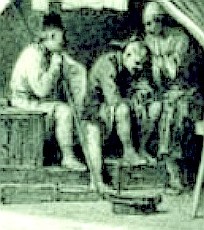
Artist: Auguste Raffet
Barbier Tzigane (1839)
that a 34 year old mariner's "Head was forthwith shav’d with a Capital Razor, when the Hair had been first moistned toward the Roots with Oyl-Olive."6 (Capital instruments were those used in capital operations - those with high mortality rates - although Moyle does not explain the difference between a capital razor and another one. Note too that Moyle repeatedly recommends the use of olive oil to wet and lubricate the hair of the head in preparation for shaving.7)
Moyle gives us another interesting insight into this process in an account of an argument between to members of the gun-crew that resulted in one of them being contused by a hand-spike. Another surgeon had initially treated the wound, thinking the the skull was undamaged. Moyle dryly noted that "'Tis true, he [the other surgeon] had shaved the Hair about the Wound, but not the whole Head, (which he ought to have done,)..."8 Moyle doesn't explain why the surgeon ought to have shaved the whole head, but his reasoning here is presumably that the surgeon could not see the extent of the wound without doing so.
Lest we think that the period surgeons overlooked the shaving of other parts of the body for surgery, we have one example of this. While this doesn't prove that other surgeons followed suit, it makes sense that they would have. Richard Wiseman advises that once the bleeding in a wound is "staid, if there be Hair growing about the Wound, shave it off: then wipe away the clotted Bloud with a Sponge dipt in Red wine, Oxycrate [an astringent mixture of water and vinegar], or Water. "9
1 William Clowes, Selected Writings of William Clowes, p. 122; 2 For examples of this, see Richard Wiseman, Eight Chirurgicall Treatises, 3rd Edition, p. 377, p. 392, p. 393 & p. 398; 3 John Woodall, the surgions mate, p. 135; 4 John Atkins, The Navy Surgeon, p. 92; 5 John Moyle, The Sea Chirurgeon, p. 107-8; 6 John Moyle, Memoirs: Of many Extraordinary Cures, p. 1-2; 7 For further examples, see Moyle, Memoirs, p. 12 & p. 18; 8 Moyle, Memoirs, p. 23; 9 Richard Wiseman, Of Wounds, Severall Chirurgicall Treatises, p. 340-1
Would Surgeons Shave Men at Sea?
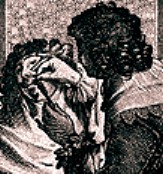
Artist: Abraham Bosse
From Le Barbier (1630s)
The only sea surgeon who comments on the role of shaving with a razor in the period sea-surgeon's manuals is John Woodall. This is probably because this role was not highly esteemed by period surgeons. Even Woodall comments, "There needeth little to be spoken of the use of this instrument, for that all men know well the use thereof, which is chiefly to shave away haire where neede requireth"1.
Those familiar with tall ships and their pitching movement while at sea have to wonder if such a delicate procedure using one the sharpest of tools in his chest would be performed at sea. Woodall gives his surgeon's mates a bit more advice that suggests this might occur. He tells the surgeon's mate that if he fails to keep his razors in good condition, "he may easily lacke the necessary use of a good Rasor, when he hath most need of it at sea; yea though he carry 10 Rasors with him."2 This is vague and could be taken several ways, but Woodall's statement does hint that a surgeon's mate would shave men at sea.
1,2 John Woodall, the surgions mate, p. 3

